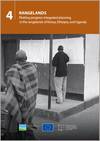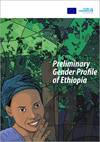Rangeland development interventions have been sectoral in their approach. Government departments, aid agencies, and organisations often focus on a particular sector, with patchy and inconsistent integration and coordination. Interventions tend to take place within the boundaries of small government administrative units, which in fact cover only a minor part of the greater rangeland. Therefore, in view of these challenges, an integrated approach to planning in rangelands is called for.
This paper draws together and reviews current and recent experience in planning processes in the rangelands of Ethiopia, Kenya, and Uganda. Some “good practice” examples are provided, and key lessons drawn from them, including strengths and weaknesses. Opportunities and principles for future interventions and support are highlighted and provide the basis for a set of recommendations.
Year of publication: 2014Organization: Coalition internationale pour l’accès à la terre (ILC)
Topic: Les savoirs autochtones, Régime foncier, Participation, Value addition
Language: English
Type of document: Technique
Geographical coverage: Afrique orientale
Les Normes et directives pour l’aide d’urgence à l’élevage (LEGS – acronyme de l’anglais Livestock Emergency Guidelines and Standards) constituent un ensemble de normes et de directives internationales pour la conception, la mise en œuvre et l’évaluation des interventions en matière d’élevage pour venir en aide aux populations touchées par des crises humanitaires. LEGS entend améliorer la qualité des réponses aux urgences en augmentant le caractère approprié, opportun et réaliste des interventions basées sur les moyens d’existence.
Year of publication: 2014Organization: Le Projet Sphère
Topic: Conflit, Résilience
Language: العربية, English, Français
Type of document: Technique
Geographical coverage: Global
Pastoralists face huge challenges in trying to sell what they produce. This book describes how to improve the markets for pastoralist products and help pastoralists overcome the cycle of poverty. The book focuses not just on pastoralists but also on other actors in livestock value chains, including traders, processors and service providers and development organizations.
Drawing on 15 cases from nine countries, this book identifies four key features of pastoralism in Africa (mobility, extensive grazing, the use of common land, and local breeds). It presents the challenges and opportunities of marketing live animals, meat, milk and leather products. It discusses better ways to ensure that pastoralists have the inputs they need to produce efficiently. It looks at three aspects of the skills and organization needed for pastoralist markets to function. Finally, it makes recommendations for government and donor policies, and discusses the best places for development efforts to intervene in order to improve marketing.
Year of publication: 2014Organization: Institut international pour la reconstruction rurale (IIRR)
Topic: Économie, Organisation, Value addition
Language: English
Type of document: Technique
Geographical coverage: Afrique du Nord, Afrique occidentale, Afrique centrale, Afrique orientale, Afrique australe
This document presents the results of an initiative, begun in 1999, that introduced co-management in four different ecosystems in Mongolia. It was based on the hypothesis that under Mongolian state ownership of pastureland and private ownership of livestock, a co-management system—with clear roles and responsibilities among herders, their communities and local governments—could offer a means to reduce the pasture degradation and overgrazing. The efforts demonstrate that if all stakeholders strongly support co-management it can be a tool to overcome the "tragedy of the commons."
Year of publication: 2014Organization: Union internationale pour la conservation de la nature (IUCN)
Topic: Régime foncier
Language: English
Type of document: Technique, Scientifique
Geographical coverage: Asie centrale
Drawing on research from Ethiopia, Kenya, Sudan and Tanzania the paper looks at the significance of pastoralism as a productive economy and the positive bearing it has on the environment, wildlife conservation, and on the health and well-being of pastoral communities. The paper also reflects on what is at stake when one form of land use is replaced by another and when customary rules and practices regarding land access, land use, and traditional law are not fully recognised by policy makers.
Year of publication: 2014Organization: Auteurs individuels
Topic: Économie, Régime foncier
Language: English
Type of document: Technique, Scientifique
Geographical coverage: Afrique orientale
Cette publication présente la disponibilité, l’accès et l’utilisation des résidus de récolte et des sous-produits agro-industriels en Afrique de l’ouest. Elle contribue aux efforts visant à appuyer les mécanismes pour établir et renforcer les évaluations des aliments pour l’élevage en Afrique de l’ouest. Les évaluations nationales des aliments pour animaux dans un pays aident à promouvoir et améliorer la résilience dans l’élevage, à appuyer l’élaboration et la mise en oeuvre des politiques d’élevage et des programmes pour des productions animales durables, à contribuer à l’utilisation de stratégies d’alimentation animale appropriées et à répondre à l’impact des inondations et de la sécheresse.
Year of publication: 2014Organization: Organisation des Nations Unies pour l'alimentation et l'agriculture (FAO)
Topic: Value addition
Language: English, Français
Type of document: Technique
Geographical coverage: Afrique occidentale
This film shows views of pastoralists' representatives on pastoralism as a sustainable form of livelihood. They expressed their views during the Global Pastoralists' Gathering held in Kiserian Kenya from 9th to 15th December 2013.
Year of publication: 2014Organization: Union internationale pour la conservation de la nature (IUCN)
Topic: Organisation, Participation
Language: English
Type of document: Vidéos
Geographical coverage: Global
Ethiopia is one of the 16 countries implementing the Global Financing for Gender Equality programme whose main objective is to increase the volume and effective use of aid and domestic resources to implement national commitments to gender equality and women’s empowerment (GE/WE). This Preliminary Gender Profile was undertaken to provide an indicative status of the level of gender equality in Ethiopia; propose recommendations on key gaps and emerging trends, and propose areas of focus for a comprehensive gender profile.
Year of publication: 2014Organization: Auteurs individuels
Topic: Jeunesse et égalité des sexes
Language: English
Type of document: Technique
Geographical coverage: Afrique orientale









